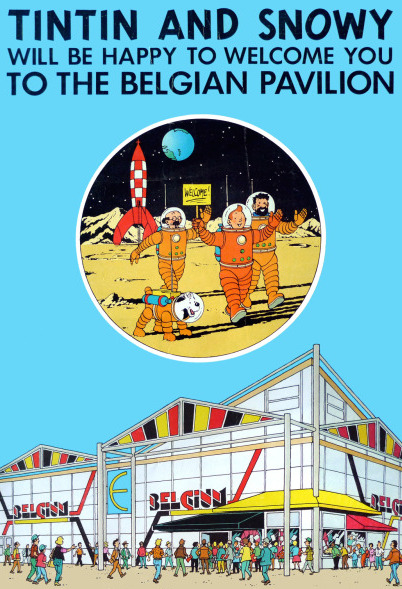Sunday, July 27, 1986.
SPACE! AT MONTRÉAL'S EXPO 67, it was strictly a superpowers frontier.
On islands separated by the LeMoyne Channel, the Soviet and American pavilions showcased the hardware of extra-terrestrial exploration.
Space. Visitors to Expo 86 quickly learn that the cosmos has become the new European frontier. Participation in the 11-nation European Space Agency (ESA) is highlighted in various striking ways in the pavilions of its member states.
Belgium, “the only country visible from space,” approaches the subject with good humour. Fairgoers are greeted by a larger-than-life-sized figure of Belgian cartoonist Herge’s famous boy reporter Tin Tin, said to have been the first comic book character on the moon.
Together with Professor Calculus, Captain Haddock and his faithful dog Snowy, a space-suited Tin Tin stands in a lunar landscape from which he welcomes pavilion visitors and directs their attention to a seven-minute video presentation called Crossroads of Europe.
Prepared by Brussels-based Terra Productions, the introductory show is presented on 34 Phillips monitors arranged to form a double entry arch and a facing wall. Orbiting astronauts can see Belgium clearly because it's the only European country to keep its highways lit at night.
Each nation, of course, highlights its own contribution to the Continental space program. The Spanish pavilion’s seven-minute Tradition and Technology multi-projector slide show features that country’s Canary Islands astrophysics laboratory, while Italy devotes a nine-screen telewall production to its aerospace industries.
Germany, a major contributor to the ESA, has its own nine-screen telewall displaying details of its D-1 space laboratory. In addition, German NASA astronauts Ulf Merbold, Reinhard Furrer and Ernst Messerschmidt are three of the eight contemporary achievers spotlighted in the pavilion's 13-minute theatre presentation, A Young Generation in Motion.
France, the ESA's keystone member, displays a touring model of its Ariane launch vehicle, while a nearby video monitor offers details of launch procedures at that nation’s Guiana Space Centre in South America. In addition, Frances's multimedia aviation show, Little By Little, includes a life-sized holographic look inside the proposed Hermes Spaceplane, Europe’s own space shuttle project.
A 3.6 m x 1.2 m (12’ x 4’) triptych, the Hermes hologram was designed by Parisian conceptual artist J. P Clausse. A white “X” on the walk-through theatre’s floor marks the spot where the three panels form their best image.
The above is a restored version of a Province review by Michael Walsh originally published in 1986. For additional information on this archived material, please visit my FAQ.
Afterword: What we remember today as “the space race,” the 20-year-long competition between the U.S.A. and U.S.S.R. for extraterrestrial supremacy, was pretty much over by the time the Europeans came together in 1975 to establish their own European Space Agency (ESA). Though the Soviets had launched the first artificial earth satellite (Sputnik 1, in 1957), put the first human into earth orbit (Yuri Gagarin aboard Vostok 1; 1961) and established the first orbital space station (Salyut 1; 1971), the Americans claimed victory overall by putting the first men on the moon (Apollo 11; 1969). The ESA was the successor to the more modest European Launch Development Organization (ELDO) and European Space Research Organization (ESRO), set up in 1961 and 1962. France made a key contribution to the their respective missions in 1968, when it opened up a spaceport, the Centre Spacial Guyanais, in its overseas equatorial département of French Guiana.
The Hermes Spaceplane, the centrepiece of France’s Expo 86 aviation presentation, was officially approved as an ESA project in 1987. In 1992, the project was cancelled, with the result that European-trained astronauts' only access to orbit has been aboard American or Russian spacecraft. Though much good work has been done by ESA scientists in the years since, little of it has been the stuff of Page One headlines. As for the popular culture, the U.S. National Aeronautics and Space Administration (NASA), pretty well owns the world’s movie screens. From the beginning, Hollywood films, such as 1982’s The Right Stuff, have set a tone of epic reverence for America’s spacemen.
See also: The eight articles included in this, the third of four Expo 86 special reports, explore the pavilions of:
|
23: Expo 86 EEC/Germany 24: Expo 86 EuroSpace 25: Expo 86 EuroRail 26: Expo 86 Czechoslovakia |
